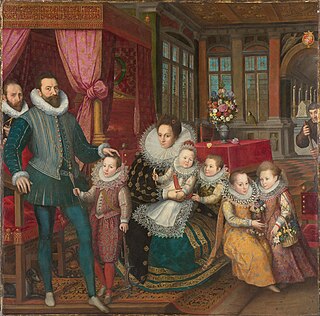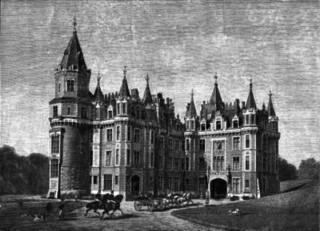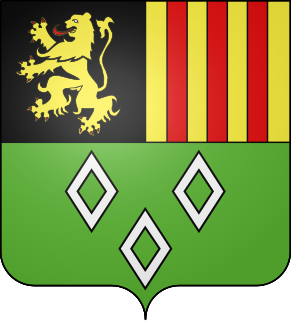
The Marquess of Wemmel was a Flemish title in use during the Ancien Régime, Wemmel is a city in Flanders.

Wemmel[ˈʋɛməl](

The Marquess of Wemmel was a Flemish title in use during the Ancien Régime, Wemmel is a city in Flanders.

Wemmel[ˈʋɛməl](
The title was created in 1688 for Philip Taye, 1st Marquess of Wemmel captain in the Spanish army. Until 1688 he was Baron of Wemmel, this title came from his ancestor Gyselbrecht Taye. His family was generations in charge of the Heerlijkheid of Wemmel. Their daughter, Marie Jospeha Taye married to the count Jean-Antoine van der Noot. The house of Taye, who was member of the Seven Noble Houses of Brussels resided in Wemmel Castle. [1]
The Seven noble houses of Brussels were the seven families of Brussels whose descendants formed the patrician class of that city, and to whom special privileges in the government of that city were granted until the end of the Ancien Régime.

Wemmel Castle is a former aristocratic estate in the centre of Wemmel in the Belgian province of Flemish Brabant. It was formerly the property of the noble house of Taye.
The marquess took an important ceremonial position and was seated in the States of Brabant, and was ceremonial Lord Chamberlain of the Archduchess. Other people of the Taye family include Maria de Taye.
The States of Brabant were the representation of the three estates to the court of the Duke of Brabant. The three estates were also called the States. Supported by the economic strength of the cities Antwerp, Brussels and Leuven, the States always were an important power before the rulers of the country, as was reflected by the charter of the duchy.
Lord Chamberlain of the Archduchess was a ceremonial function at the imperial court of Brussels.
Maria de Taye was the 25th abbess of Forest Abbey at Vorst in the Duchy of Brabant from 29 January 1609 until her death.

The Belgian nobility comprises individuals and families recognized by the Kingdom of Belgium as members of a certain class of persons. Historically, these individuals were a socially privileged class enjoying a certain degree of prestige in society. In contemporary society, much of the historic social privileges associated with being a member of the nobility has become somewhat reduced reflecting the present-day notion of egalitarianism.

Princely Count Charles of Arenberg, duke of Aarschot, baron of Zevenbergen, knight of the Order of the Golden Fleece, was the second Princely Count of Arenberg and a leading aristocrat of the Habsburg Netherlands, who served as a courtier, soldier, minister and diplomat.

The Collegiate Church of St. Gertrude is a historical building in Nivelles, Walloon Brabant, Wallonia, Belgium, which was built in the 11th century.
Asse or ASSE may refer to:

The Château des Amerois is a 19th-century neo-gothic style castle in the Ardennes forest, south-east of Bouillon, Belgium. Replacing an original building destroyed by fire, the current castle was built from 1874 to 1877 for Prince Philippe, Count of Flanders.
Van der Noot is a Dutch or Flemish surname, with several variations. Van der Noot may refer to:

Lalaing is a noble family from the south of Flanders which played an important role in the history of the County of Hainaut and of the Netherlands.

De Lannoy is the name of a noble family that takes its name from the French town of Lannoy, Nord. The name comes from l'Annoy which means «the alderwood» in Picard French of Flanders.

Marquess of Assche is a title belonging to the Belgian nobility, Assche is the old writing of the city of Asse. The Margraveships still stands today and belongs to the family van der Noot. Today the current Marquess of Assche still resides in Belgium.
Theodore Charles Antoine van der Noot, 8th Marquess of Assche and 6th Count van der Noot was a Belgian courtier and member of the high society.
Philips Erard van der Noot was the 13th Bishop of Ghent.
Count van der Noot is a title created by Emperor Charles VI on 16 May 1716. Since then this title belongs to the Belgian nobility.

Marquess of Rode is a former title of the Belgian nobility, now extinct. Rode is a former part of Schelderode in Flanders.
Marie Josepha Taye, Countess van der Noot and Marquise of Assche and Wemmel, was a noble lady from Flanders.

Glymes was a noble house of Belgium, of descendants of a bastard branch of the Dukes of Brabant. Glymes or Glimes is a municipality of Incourt. Their descendants of the branch of Grimberghen are styled as the Prince de Grimberghen.
Roger-Wauthier van der Noot born 27 /2/1644 was the Lord mayor of Brussels, he became the 1st Baron of Carloo.